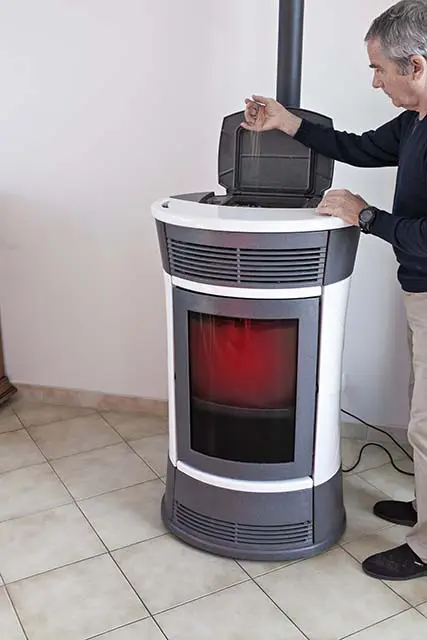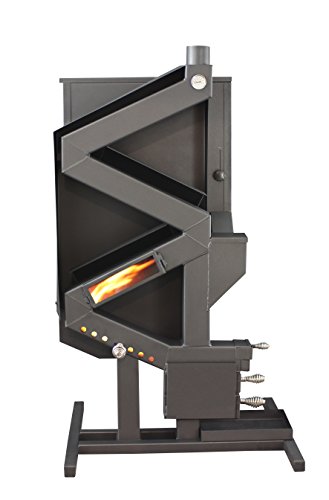- A vent-free, gas stove is ideal for small spaces. It doesn’t need any vent pipes or external attachments. You can also place it in areas you wouldn’t be able to with a vented model.
- Pellet stoves need to be vented through a side wall- so that’s a big consideration
- In terms of maintenance, pellet stoves require a lot more upkeep. You’ll need to refill it at least once a day if you’re depending on it for consistent heat. Ash also needs to be removed.
- In terms of cost, a pellet stove will likely be cheaper- you can heat a whole home with one, but you’re still going to have to buy and store the pellets.
- Natural gas is more expensive, but it is more convenient
- Both require electricity (though some older gas fireplaces don’t) to operate- a pellet stove needs electricity to distribute the heat. You can get backups for pellet stoves, but they operate for 8 hours at most and are an additional, sizable expense
- You’ll also want to compare gas prices with pellet costs (which can be pretty variable) and higher insurance costs. It could be that you may use more gas, which could make your gas prices higher.
- Another consideration, if you’re just feeling a little chilly, you can turn the gas on for just 10 minutes, whereas firing up the pellet stove fire for 10 minutes is a bigger hassle (Source).
A pellet stove or a ventless gas fireplace may be a smart investment if you reside in a place that experiences cold weather. Both solutions offer low-cost heat and can help you reduce your heating expenses while also serving as a backup heat source during a power outage. Besides, the pellet stove and gas fireplace are both aesthetically pleasing features that may enhance the appearance of your home.
But, it’s a big decision if you’re comparing the gas fireplace to a pellet stove. Both have their own set of benefits and drawbacks. While the gas fireplace is less time-consuming than pellet stove, they are typically far more costly to run. Furthermore, natural gas might not be readily accessible depending on where you live, forcing you to choose between the pellet stove or another option.
To compare the gas fireplaces vs. pellet stoves, let’s look at their fuel source, cost, power supply, safety, maintenance, and efficiency. This way, you will be able to come up with a good decision about which is the best option for you.
Contents
Gas fireplaces: Overview
The gas fireplace creates a warm and distinctive atmosphere in your home. They come in a range of designs and styles, from modern to traditional. It also helps you save money on your energy bills.
Natural gas or propane are used to power the gas fireplaces. Either way, the output is expressed in British thermal units (BTUs), with models ranging from 8500 to 100000 BTUs. The most popular versions fall between 20,000 and 60,000 BTUs, although new high-efficiency models allow you to customize the heat output.
Because the gas fireplaces require outdoor ventilation via a chimney or a direct vent to the outside of the building, they are only available as vented.
Understanding gas fireplaces
Pellet stoves: Overview
The pellet stoves work on a similar principle to traditional wood stoves, but they burn wood pellets rather than logs. Wood pellets are made of renewable resources such as sawdust, shavings, paper, and other organic materials, so they’re an environmentally friendly option to fossil fuels like oil and natural gas.
Understanding pellet stoves
Gas fireplace vs. Pellet stove
Fuel Source
Fossil fuels produce natural gas, which is then delivered by the pipeline. It is available from some local utility firms. Pellet stoves use pellets made from recycled materials like wood chips and sawdust.
Power Source
Both pellet stoves and gas fireplaces need electricity for the fans to operate (though as we noted, some gas fireplaces don’t require electricity). Gas fireplaces can still generate heat without electricity. If you lose power during the winter, the gas fireplace will keep your house warm. To operate a pellet stove, you’ll require to need some backup power.
Cost
In general, pellet stoves are less expensive than gas fireplaces. When you factor in installation costs, however, they’re roughly comparable. A new pellet stove may need a lower installation cost. When compared to the gas fireplace, the installation cost is somewhat expensive.
Pellet stoves are also less expensive in the long run because pellets cost less to use than natural gas. Since natural gas is extremely efficient, pellets’ expense is usually lower compared to the gas fireplaces.
Installation and Ventilation
Pellet stoves may be vented directly outside using a direct vent or an exhaust pipe system instead of a chimney. The direct vent system is also used to vent gas fireplaces. Because both pellet stoves and gas fireplaces need proper ventilation, the ideal installation site must be close to the exterior wall to enable direct venting.
Efficiency
When we talk of efficiency, pellet stoves are regarded as some of the most efficient – they use a little amount of fuel when necessary. With a capacity of 35,000-50,000 BTUs each hour, the pellet stove can heat a home in a square foot of 1,500 and 2,500. Gas fireplaces are similarly energy-efficient, with comparable BTUs. When the gas burns, most of the heat it generates is dispersed throughout the home.
The efficacy of the gas fireplace, on the other hand, is determined by the model. A direct-vent gas fireplace is the most energy-efficient because 70% remains in your home from the heat it produces. Not to mention that they are simple and inexpensive to install than the gas units.
Safety
Like all other gas appliances, gas fireplaces emit carbon monoxide (CO) when burning natural gas. Carbon monoxide is a possible health hazard; nevertheless, it can be prevented by venting a gas fireplace outside. Aside from that, both gas fireplace and pellet stove are quite safer to use. But, avoid touching the glass when either device while using it.
Maintenance
The pellet stoves and gas fireplaces, like any other appliance, need regular maintenance and inspection of the chimney, pipe, and vent. Particularly, pellet stoves need more regular upkeep than do gas fireplaces.
You must fill the pellet stove with pellets daily. In certain circumstances, it may be necessary to refill the stove more than once a day. After each usage, you must also get rid of the ashes. All you have to do with the gas fireplaces is turn the device on or off as required. These devices do not need an addition of fuel to empty the firebox ashes.
Gas fireplace vs. Pellet stove: What’s the difference

The basic distinction between the gas fireplace and the pellet stove is that the latter is a freestanding device, and the gas fireplace is built into a wall, most often. Someone would choose a gas stove over a gas fireplace because gasoline stoves radiate heat all around. The gas fireplace merely radiates heat out of the front since its installation.
Regardless, both of them provide warmth, ambiance, and beauty at the touch of a button. They’re frequently considered attractive choices since they don’t require a chimney, are simple to maintain, and are highly energy-efficient.
Final Thoughts
The pellet stove might be a fantastic choice if you want to save money. It will, however, need considerably high maintenance than the gas fireplace. A gas fireplace is still the best option for you, regardless of whether you’re prepared to spend a few extra dollars for convenience.



